Situated in the heart of Beirut, the capital city of Lebanon, the National Museum of Beirut stands as a testament to the country’s rich historical and cultural heritage. This iconic museum offers visitors a captivating journey through time, showcasing an extensive collection of archaeological artifacts, ancient treasures, and artistic masterpieces.
Location and Accessibility:
The National Museum of Beirut is located in the Achrafieh district of Beirut, making it easily accessible for both domestic and international visitors. It is situated on Damascus Road, near the Sports City Center, and is well-connected by public transportation. Visitors can reach the museum via taxis, buses, or by walking from nearby areas. The museum’s central location also allows for convenient exploration of other attractions in Beirut.
Historical Significance:
The National Museum of Beirut is renowned for its historical significance, housing a vast collection that spans over 5,000 years of Lebanese history. The museum was established in 1942 and has since played a crucial role in preserving and showcasing Lebanon’s cultural heritage.
Exhibits and Collections:
The museum’s exhibits are organized chronologically, guiding visitors through different periods of Lebanese history. The collection includes artifacts from various civilizations that have shaped the region, such as the Phoenicians, Greeks, Romans, Byzantines, and Ottomans. Some highlights of the museum’s collection include:
- Phoenician Artifacts: The museum proudly displays a remarkable collection of Phoenician artifacts, including intricately carved sarcophagi, statues, jewelry, and pottery. These artifacts offer insight into the Phoenician civilization, known for its seafaring prowess and cultural contributions.
- Greek and Roman Art: Visitors can explore a wide array of Greek and Roman sculptures, mosaics, and decorative objects. These artifacts showcase the influence of these ancient civilizations on Lebanon’s cultural and artistic development.
- Medieval and Islamic Art: The museum’s collection also features artifacts from the medieval and Islamic periods, including intricately designed ceramics, metalwork, and manuscripts. These objects provide a glimpse into the diverse artistic traditions of the region.
- Prehistoric Artifacts: The museum’s collection includes fascinating prehistoric artifacts, such as Neolithic pottery, tools, and human figurines. These artifacts shed light on the early settlements and cultural practices of the region.

Guided Tours and Facilities:
The National Museum of Beirut offers guided tours conducted by knowledgeable and multilingual guides, providing visitors with in-depth insights into the exhibits and the historical context of the artifacts. Audio guides are also available in multiple languages, allowing visitors to explore the museum at their own pace.
The museum provides modern facilities, including a gift shop where visitors can purchase souvenirs, books, and replicas of the exhibited artifacts. There is also a café where visitors can relax and enjoy refreshments.
Important Considerations:
- Photography: Visitors are generally allowed to take non-flash photographs in most areas of the museum. However, certain exhibits may have specific restrictions, so it is advisable to check with museum staff beforehand.
- Accessibility: The National Museum of Beirut is wheelchair accessible, ensuring that visitors with mobility challenges can enjoy the exhibits comfortably.
- Opening Hours and Admission: The museum is typically open from Tuesday to Sunday, with varying opening hours. It is advisable to check the official website or contact the museum for the most up-to-date information regarding opening hours and admission fees.
- Dress Code and Etiquette: Visitors are encouraged to dress modestly and respectfully while visiting the museum. It is customary to show reverence for the exhibited artifacts and maintain a peaceful atmosphere within the museum.
Nearby Attractions:
After exploring the National Museum of Beirut, visitors can take advantage of the museum’s central location to discover other attractions in the city. Some notable nearby attractions include:
- Sursock Museum: Located in the Achrafieh district, the Sursock Museum is a contemporary art museum housed in a stunning 19th-century mansion. The museum showcases a diverse collection of modern and contemporary Lebanese artwork and hosts rotating exhibitions and cultural events.
- Beirut Souks: Situated in the city center, the Beirut Souks offer a vibrant shopping experience with a mix of high-end boutiques, local shops, and restaurants. Visitors can explore the bustling streets, savor delicious Lebanese cuisine, and shop for unique souvenirs.
- Mohammad Al-Amin Mosque: Located within walking distance of the museum, the Mohammad Al-Amin Mosque is a prominent religious and architectural landmark in Beirut. Its grand dome and elegant design make it an impressive sight to behold, and visitors can witness the mosque’s tranquil ambiance and intricate interior details.
- Martyrs’ Square: A significant historical and cultural site, Martyrs’ Square is a public square that played a central role in Lebanon’s history. It has witnessed numerous demonstrations and political gatherings. Visitors can learn about the country’s past and enjoy the vibrant atmosphere of this central gathering place.
Safety and Considerations:
Beirut is generally a safe city for tourists, but it is always recommended to stay informed about the current local conditions and follow any travel advisories issued by your home country. It is advisable to respect local customs and traditions while visiting the museum and surrounding areas.
It is essential to be mindful of your belongings and take necessary precautions to ensure their safety. Avoid carrying large amounts of cash and keep valuables secure. It is also advisable to have travel insurance that covers medical emergencies.
Conclusion || The National Museum of Beirut
The National Museum of Beirut stands as a cultural treasure, offering visitors a remarkable journey through Lebanon’s rich history and artistic legacy. With its diverse and well-curated collection, the museum provides a captivating glimpse into the civilizations that have shaped the region. By immersing yourself in the exhibits and exploring the nearby attractions, you can gain a deeper understanding of Lebanon’s fascinating heritage. Whether you are a history enthusiast, art lover, or curious traveler, a visit to the National Museum of Beirut is an enriching experience that will leave you with a profound appreciation for Lebanon’s cultural tapestry.
Book Your Flights : Here 30% OFF on Booking
Book Your Hotels : Here 20% OFF on Booking

0 Comment